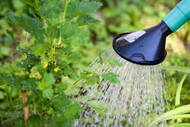Watering guide for trees and plants
Watering your plants and trees is one of the most important factors in ensuring they grow healthily and remain in good condition throughout their lifespan. However, there is much more to watering than just pouring water on your plants when its warm, which we will help teach you in this blog.
Deciding when to water
Whilst plants will need water all year round, there are times of the year where they may need a bit more due to hotter temperatures and less rainfall. Assuming we are having a typical British summer, the times where more watering would need to take place would be between May – September.
Looking into it further, we recommend watering early in the morning as the sun is rising as once the sunlight hits the plants, they will begin using the water due to the increased heat. Another advantage of morning watering would be the fact that the soil will stay drier for longer, making it less attractive to slugs and snails that can cause damage to your plants.
There is also a case to be made for evening watering as less water will be lost to evaporation due to the cooler temperatures later in the day once the sun has gone down or is on its way down. One thing we do not recommend is watering your plants at the peak heat times of the day as a large portion of the water will evaporate before the plant can absorb the nutrients from it.
How often should you water
Due to all plants having different needs based on a variety of factors, there is not a simple answer to this question and regularly watering them may not be enough, or can even be too much in some cases.
If the plant you are watering is quite large and has many big leaves, it is likely that it would need more water than a smaller plant with less leaves. Similarly, fledgling plants will need more watering in the early stages to help them develop and get through a fragile stage compared to more established plants.
The composition of your soil can also have an impact on the frequency of watering your plant will need. Some soils can hold on to water better than others, but that doesn’t necessarily make them better growing medias. For example, sandy soils are generally quite dry and would seem like they aren’t suitable for healthy plant growth, however, plants will grow better in a sandy soil compared to a clay soil which retains water more effectively. We recommend using soil dressings on your soil to maximise their water retention capabilities and give your plants the best chance at healthy growth possible.
Your planting location is another key factor to consider when watering your plants, as roots need plenty of room to grow into. Plants in small pots or near walls will need more frequent watering as the roots don’t have as much space to grow into to search out moisture, meaning they will need extra care.
Indicators to water your plants more
If you spot any of the below signs, the chances are that your plant is in need of watering more often than your current schedule:
- Leaves curling up or pointing downwards
- Stunted growth
- Wilting- This can also be a sign of overwatering so be sure to check properly
- Potted plants feeling lighter in weight
How should you water
Many people make the mistake of watering directly on to leaves or other foliage, which can actually do more harm than good. Plants only absorb water through the roots, which of course are located in the soil. Therefore, the best way to water your plants is to ensure the water is being applied as close as possible to the roots for the most effective results. Water being applied directly onto foliage will either just evaporate or can cause fungal issues in the long term which is why it is advised against.
Plants need air almost as much as water to grow effectively, so be careful to not overwater them especially if you are expecting rainfall quite frequently. Waterlogged soil can stunt your plants growth so be sure to keep an eye on your watering schedule to avoid this becoming an issue.
If watering in drought, it is better to water less frequently but more thoroughly rather than water regularly but just lightly meaning the water doesn’t reach the roots at all. Once again, we recommend watering either early morning or in the evening to minimise the amount of water lost to evaporation.
How much you should water
As previously mentioned, there are a range of factors that will affect how much you need to water your plants, so be sure to consider them all when watering.
If watering plants in a container, the general rule is to apply 10% of the containers volume. For example, for a 5 litre hanging basket you would add 500ml of water. Do not dump the water in all in one go, it is better to pour it in slowly so it doesn’t immediately drain out of the bottom before being absorbed by the roots. If you are watering a small pot, lift it up slightly once you have finished watering and assess the weight, if it feels light you may need to add more water.
Keep an eye on the physical condition of your plants in between waterings, if you are noticing wilting or any of the other indicators mentioned above, that may mean that you need to water more often or more effectively.
There are many things to consider when it comes to watering your plants, be sure to let us know if this advice page helped you with your watering needs.

